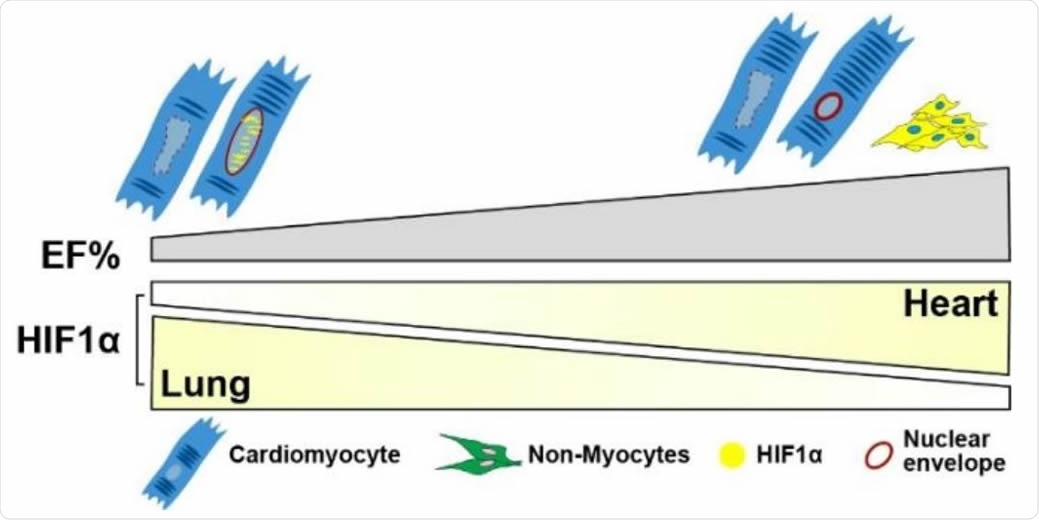The COVID-19 pandemic, caused by the severe acute respiratory syndrome coronavirus 2 (SARS-CoV-2), which first emerged in Wuhan, China, in late December 2019, has quickly become the most urgent issue facing scientists worldwide. It has been reported that the respiratory infection causes cardiac dysfunction in 25-55% patients, including hospitalized patients and non-critical patients.
“Surprisingly, increasing incidents of myocardial injury with sustained cardiac involvement was found in many patients months after recovery from COVID-19, with a proportion of patients with no known history of previous cardiac symptoms”, says the team at Icahn School of Medicine at Mount Sinai, New York.
SARS-CoV-2 is responsible for triggering respiratory illness leading to symptoms such as difficulty in breathing and chronic pulmonary and cardiovascular hypoxia. Research has shown that under low oxygen conditions associated with COVID-19, the hypoxia-inducible factor 1 alpha (HIF1α), known to be the master regulator of hypoxia, gets stabilized and protects against SARS-CoV-2 infection.
“This study establishes a direct link of cardiac cellular responses to hypoxic stress with matching functional and histological data, serving as one of the first studies to bridge previous stand-alone clinical data and cellular data,” says the team.
A pre-print version of the research paper is available on the medRxiv* server, while the article undergoes peer review.
.jpg)
How does HIF1α protect COVID-19?
As mentioned above, under low oxygen conditions, HIF1α does not undergo oxygen-dependent proteolysis and accumulates in the nucleus. This accumulation results in dimerization with HIF1β, which then binds to the hypoxia-response elements (HREs).
“HIF1α stabilization leads to an avalanche of transcriptional activities involving angiogenesis, proliferation, homeostasis, inflammation, and metabolic switch”, says the team.
A recent study has shown that stabilization of HIF1α leads to a decrease in ACE2 receptors, which are the entry point of the SARS-CoV-2 virus. A different study also suggested that a decrease in SARS-CoV-2 pathogenicity at high altitudes was also due to a decrease in ACE2 receptors in response to hypoxic environments.

What did the study involve?
This study involved two groups of COVID-19 patients, those with preserved cardiac function having Ejection Fraction (EF) greater than 50 percent and those with moderate to severe cardiac dysfunction having EF less than 45 percent.
The echocardiography data, which involved both systolic and diastolic function, was examined along with post-mortem samples. Additionally, the heart samples were immunostained with primary and secondary antibodies.
The study of apoptosis was carried out by the hep of TUNEL assay, which used in situ cell death detection kit. Quantitative RT-PCR was carried out of the post-mortem lungs to detect the presence of RNA. Finally, Transmission Electron Microscopy (TEM) was performed on a control heart sample that did not have COVID-19 history.
What did the study find?
The researchers found that in preserved hearts, the expression of HIF1α is mostly in non-myocytes that help protect endothelial cells.
“Endothelial cells adapt to hypoxia by activating HIF1α and orchestrating a number of genes involving cellular metabolism, anti-apoptosis, and proinflammatory response”, says the team.
The nuclear envelope in low EF heart is thinner than preserved EF heart which results in loss of function, sarcomeric damage, and myofibril abnormalities.
“These data suggest that cell-type dependent HIF1α expression is increased in hearts of COVID-19 patients with preserved cardiac function”, adds the team.
What did the authors conclude?
“Our data provide compelling evidence of the protective role played by HIF1α in hearts of patients affected by COVID-19”, says the team.
The protective role of HIF1α in hearts may not only help to predict cardiac involvement in COVID-19 patients but also help to understand mechanisms involved in other forms of viral cardiomyopathy.
*Important notice
medRxiv publishes preliminary scientific reports that are not peer-reviewed and, therefore, should not be regarded as conclusive, guide clinical practice/health-related behavior, or treated as established information.
- Chaudhry, H.W. et. al. (2021). HIF1alpha Cardioprotection in COVID-19 Patients. medRxiv pre-print. doi: https://doi.org/10.1101/2021.08.05.21258160 . https://www.medrxiv.org/content/10.1101/2021.08.05.21258160v1
Posted in: Medical Research News | Medical Condition News | Disease/Infection News
Tags: ACE2, Angiogenesis, Antibodies, Apoptosis, Assay, Breathing, Cardiomyopathy, Cell, Cell Death, Chronic, Coronavirus, Coronavirus Disease COVID-19, Cytoplasm, Electron, Electron Microscopy, Genes, Heart, Hypoxia, Inflammation, Lungs, Medicine, Metabolism, Microscopy, Morphology, Nuclear Envelope, Oxygen, Pandemic, Proliferation, Research, Respiratory, Respiratory Illness, RNA, SARS, SARS-CoV-2, Severe Acute Respiratory, Severe Acute Respiratory Syndrome, Stress, Syndrome, Virus

Written by
Suchandrima Bhowmik
Suchandrima has a Bachelor of Science (B.Sc.) degree in Microbiology and a Master of Science (M.Sc.) degree in Microbiology from the University of Calcutta, India. The study of health and diseases was always very important to her. In addition to Microbiology, she also gained extensive knowledge in Biochemistry, Immunology, Medical Microbiology, Metabolism, and Biotechnology as part of her master's degree.
Source: Read Full Article
